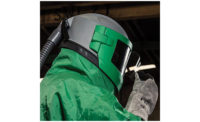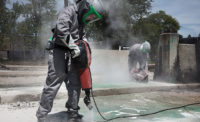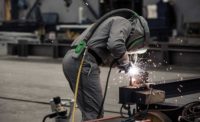How do supplied air, loose-fitting respirators eliminate excessive spending, safety issues and downtime? Keeping employees safe can be a huge expense to your company. But when you consider what’s at stake, human lives and life’s best moments, personal safety is invaluable. The good news is, it doesn’t mean that protecting your employees will stifle your business, because if you choose the right protection, it will also eliminate excessive spending, safety issues and downtime. This way, safety becomes an investment that earns a return.
What is a supplied air respirator?
Supplied air respirators provide compressed air through an airline, filter and flow control device to your respirator. Other types of respirators include powered air purifying respirators (PAPR) which utilizes a motor, battery and a fan to draw air through a small filter mounted on the operator’s hip or back, and negative pressure respirators which require the wearer to breathe to filter the air.
What is a loose-fitting respirator?
Loose-fitting respirators typically cover the entire head as opposed to tight-fitting respirators, such as a full-face or half-face mask. Because they cover your head and are always used with supplied air, loose-fitting respirators don’t require a seal between the respirator and the user. Tight-fitting respirators, supplied air or negative pressure, do require a seal.
Supplied air respirators typically utilize a large, heavy duty filter. The size of the filter along with the fact that it is drawing air from outside the immediate working environment means the filter cartridge doesn’t need replacing as often as a PAPR. which uses smaller filters that draw air from the immediate working area.
No seal is required between a loose-fitting respirator and the user. This eliminates the ongoing expense of fit-testing.
Supplied air, loose-fitting respirators provide greater protection than those that are tight-fitting or use a PAPR. Supplied air, loose-fitting respirators have an Assigned Protection Factor (APF) of up to 1000, while tight-fitting respirators have an APF maximum of 50.
As stated earlier, tight-fitting respirators require fit-testing. However, the seal is only secure under the same conditions that it was tested at. For example, if the user puts on weight or has any facial hair growth, the seal is jeopardized.
Air supplied (both SAR and PAPR) provide breathable air to the respirator, allowing the wearer to breathe easily. Negative pressure respirators require the wearer to breathe through a filter which can cause additional pressure to the heart.
Loose-fitting respirators have a wider range of compatible safety additions. Certified eye protection, hearing protection and head protection are available in some loose-fitting respirators, either in-built or as optional extras.
Reducing downtime
Loose-fitting respirators are more comfortable than tight-fitting respirators. This reduces fatigue and means that you can operate for longer periods of time before needing a break.
Supplied-air respirators have air conditioning options, allowing you to work at a comfortable temperature, also reducing fatigue and enabling you to work longer with less breaks.
Scenarios
The following scenarios highlight the impact different respiratory systems have on your business.
- Scenario 1: An automotive painting company has 15 painters. Each painter has a supplied air, loose-fitting respirator. They charge out at a rate of $65 per hour.
- Scenario 2: Each of the 15 painters wear a tight-fitting, cartridge mask. They also charge out at a rate of $65 per hour.
Effect on costs and savings
Scenario 1:
A loose fitting respirator would initially cost $13,860.
The ongoing annual cost would be:
Replacement filter cartridges each quarter: $44 x 3 x 4 = $528
Replacement respirator parts: $4,000
Total: $4,528
Scenario 2:
A half-face, tight-fitting respirator would initially cost $3,510.
The ongoing annual cost in scenario 2 would be:
Replacement filter cartridges each week: $12 x 15 x 52 = $9,360
Total: $9,360
The annual productivity savings for scenario 1 are:
Productivity increase (24 mins/day, 2 hrs/wk): $60 x 15 x 2 x 52 = $93,600
Reduced Downtime (60 mins/day, 5 hrs/wk)*: $60 x 15 x 5 x 52 = $234,000
*Rationale explained below
Effect on safety
Scenario 1: loose-fitting, air-supplied respirators have an APF rating of 1000. Users will benefit from complete protection and comfort which will minimize fatigue and maximize their quality of living.
Scenario 2: tight-fitting, negative pressure respirators have an APF rating of 50. While safety standards can be met, users may be subjected to minor dangers that can have a cumulative effect, and the discomfort experienced can cause fatigue and pain.
Effect on downtime
We estimate that users wearing tight-fitting, negative pressure respirators need four 15-minute breaks each day. That means users wearing loose-fitting, air-supplied respirators gain 60 minutes per day just on downtime.



